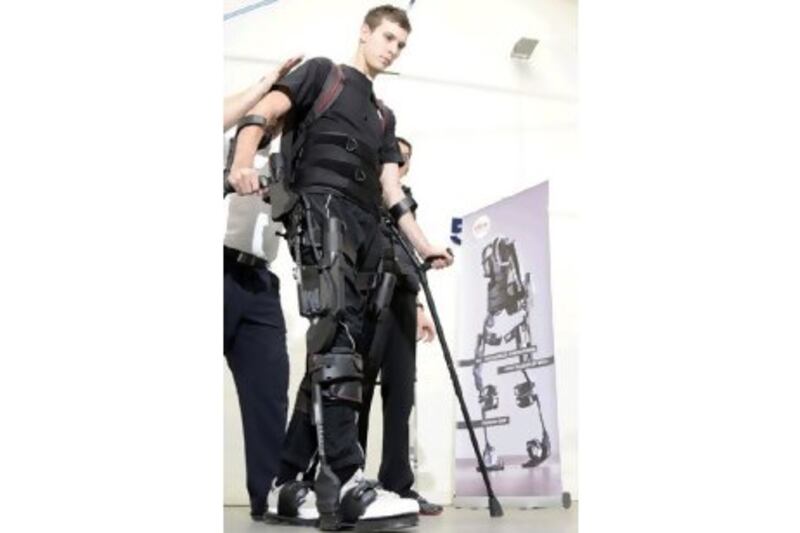David Follett feared he would be wheelchair-bound for the rest of his life, until bionics put him on the path to rehabilitation.
Mr Follett suffered a broken neck and spinal injuries in a traumatic traffic accident about five years ago.
Now a newly developed bionic exoskeleton, the Ekso, has helped him to stand and take his first steps back.
"I have had roughly two weeks of training, about 10 sessions," said Mr Follett, 22, from the UK. "I really enjoy using it and I seem to improve after every use and walk."
The device will become available in UAE clinics and rehabilitation centres in July.
The exoskeleton suit, which is strapped over the user's clothing with Velcro, helps patients with spinal injuries to stand and walk.
It uses sensors to observe the gestures the wearer makes to determine their intentions, then acts accordingly. A computer draws on the sensors and other input devices to orchestrate each tiny aspect of a single stride.
While experts in the country are excited about the technology, the first device of its kind to make its way to the UAE, they said some important questions needed to be answered.
Dr Suad Trebinjac, a consultant and head of physical medicine and rehabilitation at Rashid Hospital, said the main question was how often it needed to be charged.
"The purpose of such a device is to allow patients to live as close to a normal life as possible," Dr Trebinjac said.
"Can an individual perform their regular daily tasks, such as going to work and shopping for groceries? Or do they have to continuously keep charging it?"
The device is powered by two high-capacity lithium batteries that hold a charge for four hours.
It weighs 23 kilograms and can be adjusted to fit most people who weigh 100kg or less and who are between 1.5 and 1.9 metres tall, with partial upper body strength.
The suit, for now, is meant to be used in a clinic or rehabilitation centre, said Andy Hayes, the managing director of Ekso Bionics.
"At the moment, as this is a new technology, Ekso is to be used only under clinical supervision and indoors on a flat surface," Mr Hayes said.
"However, our goal is to develop [the device] to accommodate people in their daily life, making it easier to go outside the house and even back to work."
As well as spinal injuries, the Ekso can be used for patients with other neurological disorders or lower-extremity weakness.
A major challenge for this type of "developing technology" would be figuring out a method to connect the device directly to the functional nerves, said Dr Matthias Honl, a specialist orthopaedic surgeon at the Neuro Spinal Hospital in Dubai.
Dr Honl said the best place for such a connection would be at the area where the spinal cord had been damaged. This problem is not specific to this device but for bionics in general, he said.
"For example, experts are trying to use a camera chip that makes light from an electrical signal to help those with vision problems," Dr Honl said. "But the question is, how to bring it to the nerve."
Similar technologies to the Ekso are available on the international market, including the Rex by Rex Bionics and the ReWalk by Argo Medical Technologies.
Dr Heike Vallery, an assistant professor of biomedical engineering at the Khalifa University of Science, Technology and Research, said bionic products were yet to be commonly used in clinics, and described them as a "work in progress".
The technology must be customised to each patient's needs, Dr Vallery said, and should also take into consideration possible complications, such as muscle spasms.
"If there is a spasm, how will the device react?" she asked. "Will it force the system to go through, which could potentially damage the muscle? Or will it be compliant to the spasm, which could result in the user falling? All this needs to be taken into consideration."
Mr Hayes said designers had taken these factors into account.
"Before putting the device on, the physiotherapist usually stretches and massages the patient," he said.
"All our test pilots and users so far have experienced a reduction in spasticity after walking in Ekso."
Experts say making the device available in the UAE is a step in the right direction, as standing upright has physiological and mental benefits.
"Paraplegic patients can go on living their lives but being on a wheelchair the whole day gives them problems," Dr Honl said. "One … is that because they are sitting all day they get wounds, pressure sores.
"Secondly, in their social life, the main burden is that they are always lower than other people and are never able to stand up. So both physically and mentally, they are never equal partners."
For Mr Follett, being able to stand again made all the difference.
"At first I started walking with a frame to get a feel for it and find my balance," he said. "But soon I moved on to walking with crutches and virtually independently, something I felt I wouldn't be able to do again.
"This gets easier and easier with practice and is as close to 'normal' walking as I can remember."
nhanif@thenational.ae





